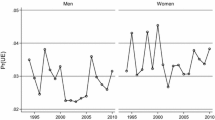Abstract
One of the principle aims of the Working Families’ Tax Credit in the UK was to increase the participation of single mothers in work. The difference-in-differences methodology that is typically used to evaluate tax credit policies compares single mothers with single women without children. However, the characteristics of these groups are very different, and changes over time in relative covariates are likely to violate key identifying assumptions. We find that when we control for differential trends between women with and without children, the employment effect of the policy falls significantly. Moreover, closer inspection shows that while there was an effect on increasing the likelihood to work full-time (30 h or more), there was no effect on reducing the likelihood to be inactive. Looking closely at important covariates before and after the policy introduction, we can see sizeable changes in the relative returns to employment between the treatment and control groups, making it difficult to assess the policy effectiveness.











Similar content being viewed by others
Notes
These figures are taken from the “Working Families’ Tax Credit Statistics,” Inland Revenue Quarterly Enquiry (2003).
The basic credit increased progressively from \({\pounds }\)52.30 in 1999/2000 to \({\pounds }\)62.50 by 2002/2003. The bonus credit increased progressively from \({\pounds }\)11.05 in 1999/2000 to \({\pounds }\)11.65 by 2002/2003. The child tax credit increased progressively from \({\pounds }\)19.85 in 1999/2000 to \({\pounds }\)26.50 by 2002/2003.
The program allowed single parents to meet a personal advisor every 2 weeks and receive advice on job vacancies, in-work benefits, childcare arrangement, training, and job-search techniques.
Because of possible interaction with other policies, some caution is needed when comparing single mothers and single women without children: both groups were eligible for different types of support when not working, which could influence whether they would be unemployed or inactive. Single mothers could claim Income Support when not working, while single women without children had to claim Jobseekers’ Allowance, which has more stringent conditionality attached. Thus the composition of the inactive group among single women without children is likely to be very different to the single mothers.
Note that under the assumption of differential trends, this effect is smaller, as we need to net out the pre-existing trend, yielding a (significant) coefficient of 0.022.
References
Azmat G (2012) Incidence, salience and spillovers. The direct and indirect effects of tax credits on wages. Working paper
Blundell R, Duncan D, McCrae J, Meghir C (2000) The labour market impact of the working families’ tax credit. Fiscal Stud 21(1):75–104
Blundell R, Brewer M, Shepard A (2005) Evaluating the labour market impact of the working families’ tax credit using difference in differences. HM Revenue and Customs Working Paper No. 4
Blundell R, Francesconi M, Van der Klaauw W (2011) Anatomy of policy reform evaluation: announcement and implementation effects. Working paper
Brewer M, Browne J (2006) The effect of the working families’ tax credit on labour market participation. IFS Briefing Note No. 69
Brewer M, Duncan A, Shephard A, Suarez M (2006) Did working families’ tax credit work? The impact of in-work support on labour supply in Great Britain. Labour Econ 13(6):699–720
Brewer M, Francesconi M, Gregg P, Grogger J (2009) Features: in-work benefit reform in a cross-national perspective. Econ J 119:F1–230
Dilnot A, McCrae J (2000) The family credit system and the working families’ tax credit in the United Kingdom, OECD Economic Studies No. 31, 2000/11
Duncan A, Giles C (1996) Labour supply incentives and recent family credit reforms. Econ J 106(434): 142–155
Eissa N, Leibman JB (1996) Labour supply response to the earned income tax credit. Q J Econ 111:605–637
Eissa N, Nichols A (2005) Tax transfer policy and labor market outcomes. Am Econ Rev Pap Proc 95:88–93
Francesconi M, Van der Klaauw W (2007) The socioeconomic consequences of in-work benefit reform for British lone mother. J Hum Resour 42:1–31
Francesconi M, Rainer P, Van der Klaauw W (2009) The effects of in-work benefit reform in Britain on couples: theory and evidence. Econ J 119:F66–F100
Goodman A, Shephard A (2002) Inequality and standards of living in Great Britain: some facts. Institute for Fiscal Studies Briefing Note No. 19.
Gregg P, Harkness S (2003) Welfare feform and lone parents in the UK. CMPO Working Paper Series No. 03/072
Gregg P, Harkness S, Smith S (2009) Welfare reform and lone parents in the UK. Econ J 119:F38–F65
Manning A, Petrongolo B (2008) The part-time penalty for women in Britain (with Alan Manning). Econ J 118:F28–F51
McKnight A (2005) Employment: tackling poverty through ’Work For Those Who Can’. In: Hills J, Stewart K (eds) A more equal society. Centre for Analysis of Social Exclusion (CASE), London School of Economics
Revenue Inland (2003) Working families’ tax credit & family credit statistics. Quarterly Enquiry, November 2003
Acknowledgments
I would like to thank the referees of this journal, Manuel Arellano, Richard Blundell, Mike Brewer, Vicente Cuñat, Alan Manning, and Steve Pischke for insightful comments and suggestions. Financial support from the Spanish Commission of Science and Technology [ECO2011-30323-C03-02] and the ESRC, given through the Centre for Economic Performance, is gratefully acknowledged.
Author information
Authors and Affiliations
Corresponding author
Rights and permissions
About this article
Cite this article
Azmat, G. Evaluating the effectiveness of in-work tax credits. Empir Econ 46, 397–425 (2014). https://doi.org/10.1007/s00181-012-0678-x
Received:
Accepted:
Published:
Issue Date:
DOI: https://doi.org/10.1007/s00181-012-0678-x




